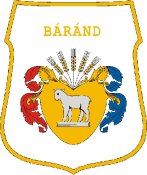Báránd

Báránd is situated 50 kilometres away from Debrecen in the South Western part of Hajdú-Bihar county. It is the west-most settlement of the Bihar county.The trunk road 42 crossing the village connects Budapest with the frontier station at Ártánd. It can be accessed from Debrecen on road 4801. It has direct railway connection to the capital and the Rumanian border. It also has regular coach service to Püspökladány and Földes.
Archaeological findings allow for the conclusion that Báránd has been inhabited since at least 5000 BC. The settlement came into being on the original terrain dissected by natural waters.The village was built on the mounts in the marshes. Due to the embanking and land drainage in the previous century the terrain has desiccated. The name of the settlement is assumed to originate from a Slavonic or Turkish common noun. It first appeared in a charter of László IV from 1285. It was the estate of the Bishop of Várad in the Middle Ages. The village survived the Turkish rule of Hungary and the 17th century. Its inhabitants converted to Calvinist creed when the Reformation reached Hungary. But in the 18th century it became an estate of the reorganised episcopacy of Várad. In spite of that the majority of residents remained still Calvinist.
The first official census of 1870 in Hungary the population of the village was 3664 and now it has 3029 residents. 22 % of the population are old age pensioners, 25% are children or juvenile while the proportion of the active population is about 54%. In the village only primary education is provided in a 16 classroom-primary school and in a kindergarden. Medical care is provided for the village by two general practitioners, a dentist, a health visitor and a pharmacy. Specialist care is available either in Püspökladány or in Berettyóújfalu. Báránd has less than excellent agricultural assets that provides the primary basis of livelihood. 15 % of the active population works in the agricultural sector while 5, 3 and 2 % is employed in industry, commerce and tourism, and transportation . Public services, education and medical care employ 6 % of the population. 15 % of the active population is unemployed. According to recent statistical survey in the village there are a limited-liability company, 3 commandite partnerships and 46 private entrepreneurs. The largest economic organisation is the co-operative employing 150 people. It principal lines of activity are farming, agricultural services and herding. The infrastructure of the village is far from being satisfactory. The international highway crossing the village causes environmental hazard. 20 % of homes in the villages are not connected to the water pipeline, 56 % of them has gas and 40 % is on the telephone. The village has no sewage system and only 16 % of the roads are paved. The baroque Calvinist and Catholic churches, the latter was rebuilt in 1891 , are worth mentioning. The baroque statue of St. John of Nepomuk, the memorial of the heroes of World War II and the statue of Lajos Kossuth can be seen on the main square. The most important plans for development are building a by-pass and the 7 or 8 kilometre long road connecting Báránd and Biharnagybajom. Belzyce, in Poland is the sister settlement of Báránd since 1986.





